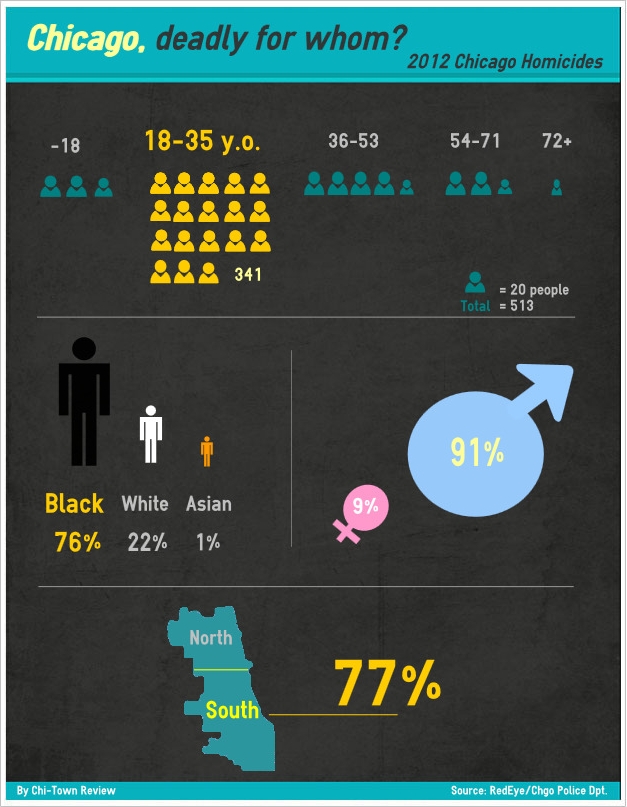Black males 18-35 made up more than half of Chicago’s 513 murder victims in 2012. The homicide count is the city’s highest in four years.

Graphic by Chi-Town Review
Chicago saw 513 homicides in 2012–the highest in four years. Experts say the victim profiles point to the city’s larger socioeconomic issues.
Seventy-seven percent of the deaths were in South Side neighborhoods (south of Madison Street), many of which struggle with gang violence and income disparities.
The rising count made national news shortly after Christmas when it reached 500 . At the very start of the year, Police Supt. Garry McCarthy announced the department’s year-end tally at 506 murders.
But crime experts warn citizens not to read too much into that number, the Chicago Tribune reports. Several factors, including the unseasonably warm year, could have contributed to the spike. In the bigger picture, Chicago’s homicide rate has been lower in recent years, compared to the the 90s and early 2000s.
Harold Pollack, co-director of the University of Chicago Crime Lab and contributor to the The Incidental Economist academic blog, writes that the crime spike is unfortunate, but not unusual.
“The idea that Chicago faces a unique or unprecedented rise in homicides is incorrect,” Pollack wrote. “Our problems are all too familiar and chronic throughout much of urban America.”
Not all Chicagoans face the dangers of shootings and gang violence. Many residents live in areas that saw little to no homicides. Victims in last year’s tally were disproportionately black, male South and West Siders under 35.
Gang violence is the leading contributor to the overall number–about 80 percent, McCarthy and city officials say. Eighty-six percent of last year’s homicides were shootings, which McCarthy says is largely due to gangs possessing guns.
The superintendent added more officers on streets to tackle the issue, hoping to also learn more about the highest-risk communities.
But others say socio-economic factors are often overlooked.
“Our nation recently committed hundreds of billions [of] dollars because it was unthinkable to allow our financial system to collapse,” Pollack wrote. “We’ve shown a conspicuous lack of similar urgency in addressing the human problems these young people face: not just the violence, but also widespread joblessness, poverty, home foreclosures, and public heath problems in these same hard-hit communities.”
The total number of homicides is sometimes significantly lower, or near-non-existent in areas with higher income and education–wealthier neighborhoods like Lincoln Park, where more 50 percent of the population is college educated and makes more than $70,000 a year, the New York Times shows.
Editor’s Note: The Chicago Police Department’s official 2012 homicide tally is 506. Raw data compiled by RedEye, and also publicly available, puts the total at 513. That data includes shootings in which no suspect is charged, unlike Police Department counts. CTR’s plots come from this pool. For more on how RedEye collects the numbers visit the RedEye Homicide Tracker.
